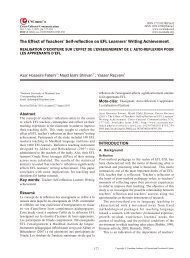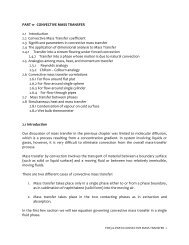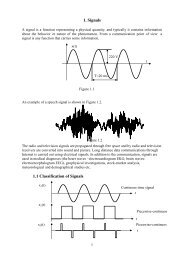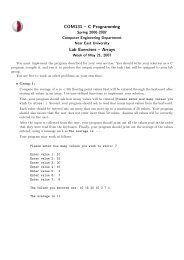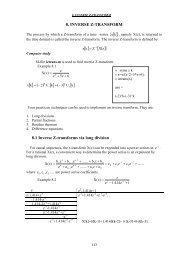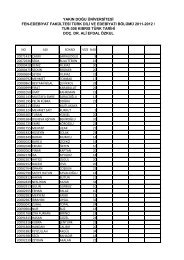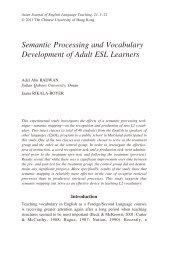GSM ARCHITECTURE
GSM ARCHITECTURE
GSM ARCHITECTURE
You also want an ePaper? Increase the reach of your titles
YUMPU automatically turns print PDFs into web optimized ePapers that Google loves.
<strong>GSM</strong> <strong>ARCHITECTURE</strong>OperatorOMSExternalnetworksNSSBSSMS<strong>GSM</strong>UserMobile Station (MS),Base Station Subsystem (BBS),Network and Switching Subsystem (NSS),Operation Management Subsystem (OMS).External networks NSS BSS MS UsersFahreddin Sadıkoğlu 1
PSTNASNSSISDNVLRHLREIRPSDNPLMNMSCOMSAsub interfaceBSCBSSAbis interfaceBTSUm interfaceMSSIMFahreddin Sadıkoğlu 2
BSS components and interfacesBTSBTSOSSBSCNSSBTSAsub interfaceRadio interface(Um)Figure 4.12Abis interfaceMessageSignallingFahreddin Sadıkoğlu 3
Base StationTRXn.BSC.TRX2TRX 1Fahreddin Sadıkoğlu 4
BLOCK DIAGRAM OF A BASE STATIONA-bisReceiverADEqualizerMod./Dem.13 kbitsSpeech 8/13 bitCodec 13/8 bit64 kbitsA lawVCO Synthesizer Control Channel Codec SignalingUnit64kbits16 kbitsTransmitterADBurst buildingMultip./Dem.Speech 8/13 bitCodec 13/8 bit64 kbitsBTSBSCFahreddin Sadıkoğlu 5
Radio Frequency channels for <strong>GSM</strong> D900890-915 MHz for uplink, MC to BS935-960 MHz for downlink, BS to MSfup(n)=(890+0,2xn) MHz(with,ARFCN 1≤n≤124)fdown(n)=fup(n)+45MHzRadio frequency channel spacing: 200 kHz; Duplex spacing: 45 MHzCHANNEL DISTRIBUTION FOR D900UplinkDownlink001 002 123 124001 002 123 124890 890.2 914.8 915 935 935.2 959.8 960200 kHz Channel spacingDuplex spacing 45 MHzFahreddin Sadıkoğlu 6
<strong>GSM</strong> EXTENDED BAND (E-<strong>GSM</strong> 900)880-915 MHz for uplink ; 925-960 MHz for downlinkWith FDMA 124 (174 for extended band )Fup(n)=(890+0.2 x n)MHz (with ARFCN 0≤n≤124 ) andfup(n)=(890+0,2xn) (n-1024) (with ARFCN 975≤n≤1023)fdown (n)=fup (n)+45 MHzRadio frequency channel spacing: 200 kHz; Duplex spacing: 45MHz<strong>GSM</strong> 18001710-1785 MHz for uplink; 1805-1880 MHz for downlinkDuplex spscing is 95 MHz with 374 channels 200 kHz spacingNumberd with 512-885fup(n)=(1710+0,2xn) (n-511)(with,ARFCN 512≤n≤885fdown(n)=fup(n)+95MHzFahreddin Sadıkoğlu 7
<strong>GSM</strong> FRAME STRUCTUREHyper FrameSuper FrameMultiframeFrame0 1 20470 1 42 43 44 45 46 47 48 49 500 1 17 18 19 20 21 22 23 24 240 1 2 3 4 5 6 71250 bits;Duration4.615ms3 57 1 26 1 57 3 8.25Time SlotST Data S Training S Data SP G156.25 bitsDuration 3.48 hoursDuration 6.12 s25Duration 120 msST:Start Bits (Tailing bits-000)S:Stealing BitSP:Stop Bits (Tailing bits-000)G:Guard BitsDuration 577 µs(156x3.9 µs )Normal burst3 57 1 26 1 57 3 8.25ST Data S T S Data SP GFahreddin Sadıkoğlu 8
Control ChannelsCCH( Control Channels )DCCHBCCHSDCCHACCHBCCHSynch.FACCHSACCHSCHFCHCCCHRACHCBCHPCH/AGCHFahreddin Sadıkoğlu 9
<strong>GSM</strong> PHYSICAL LAYERMicrophoneADCMicrophoneADCSpeech codingLPC-PEALinear Predictive coodingRgular Pulse ExcitationAnalysisLong-Term PredictionSpeech DecodingShuflingInterleavingChannel coodingCipheringDecreases possibility ofdistortion of consecitivebits in radio channelCyclic and Convolutionalcodes for error detectionand correction purposeIs used to protect dataKi+Rand A8 KcDeShuflingDeInterleavingChannel decoodingDecipheringModulationGMSKDemodulationChannelFahreddin Sadıkoğlu 10
Speech and Channel CodingM0.3-3.4 kHzBPFf s =8kHz;13 bits 104 kbsADSpeechEncoder13kbsChannelCoding22.8 kbsTo ModulatorLPFADSpeechDecoderChannelDecoderFrom DemodulatorSpeechEncoderEvery 20 ms160 samplesBlock Filters12341 5 . 372 6 . 383 7. 394 8. 40SelectionSequence withmaximal energyLinear Predictive Coding and Regular Pulse Extantion –LPC/RPECyclic CodingFor errordetectionChannel189bitsEncoderConvolutionalCoding for 1 biterror correction456bitsS iCorrelationΒanalysisC(S i , S i-k )=maxΒ= S i -S i-kLong Term Prediction-LTPReorderingRestructuringInterlivingFahreddin Sadıkoğlu 11
GMSK MODULATIONSin 2πf c td(t)Integraterd i (t)GaussianFilterC(t)COS(c(t))Sin(c(t))I(t)Q(t)XX+m(t)I( t) cos( c(t));Q(t) sin( c(t))Cos 2πfctm(t) I(t)sin 2fctQ(t)cos2fctFahreddin Sadıkoğlu 12
AUTHOINTICATION MSKiMSUm InterfaceRandNetworkSRESA3 Algorithm=?SRESYes/NoDATA CIPHERINGKiA8MSRandDataMSA5UmInterfaceKcCipherdDataNetworkKcDataA5KcFahreddin Sadıkoğlu 13
Convolutional CodingFahreddin Sadıkoğlu 14
Functional Sequence of Basic Call TypesMobile Originated Call (MOC) to the fixed networkBefore an MOC begins a location registration and with it an authentication must have taken place.The MS sendsthe call setup information dialed by the mobile subcriber to the MSC (1). The MSC requests call informationfrom the VLR (mainly about any relevant restictions) concerning the mobile subscriber identified by the IMSI (2).After assigning a traffic channel, the MSC then informs PSTN.Calling subscriberMS1CalledsubscriberBTS/BSC/TRAUBSS1NSCVLR2MSC3PSTNNPLMNFigure 4.16Fahreddin Sadıkoğlu 15
Mobile Internal Call (MIC)The MS1 sends the call setup information dialed by the mobile subscriber (MSISDN) to the MSC (1).The MSC requests informaton about the calling mobile subscriber MS2 from the VLR (2). The MSCuses the dialling information (MSISDN) to establish the HLR and sets up signalling connection to it (3).The HLR sends a request to the VLR in whose area the called mobile subscriber MS2 is currently roaming (4).The VLR sends the requested MSRN back to the HLR. The HLR forwards the MSRN to the MSC (5).Steps (6) to (9) are the same as steps (6) to (9) in Figure 7.17.MS1MS21CallingsubscriberCalledsubscriber887 9BTS/BSC/TRAU 1BSS1BTS/BSC/TRAUMSCBTS/BSC/TRAU8 7 926NSC3 VLR54HLR5PLMNFahreddin Sadıkoğlu 16
Mobile Terminating Call (MTC) From The Fixed NetworkA call for mobile subscriber arrives at the GMSC (1). The GMSC uses the dialing information (MSISDN) to establish the HLR and sets up a signaling connection to it (2). The HLR sends a requested VLR in whose area the calledsubscriber is currently roaming (3). The VLR sends the requested MSRN back to the HLR. The HLR forwards the MSRNto the GMSC (4). On the basis of the MSRN the GMSC sets up the connection request to the MSC, i.e. the MSC inwhose area the mobile subcriber is roaming at this point in time (5).As the MSC does not know the mobile subscriber up to this point, the MSC requests the mobile subscriberinformation for the call setup from ıts VLR (6). The MS is now called by means of paging to all BTS/BSCs in the locatıonarea, as the radio cell in which the MS is located is not known to the MSC (7). If there is a response to the paging, thisinformation is transmitted to the MSC (8). Finally the connection to the MS is set up (9).Figure7.17 shows the call sequence of an MTC .MSCalledsubscriber78 9BTS/BSC/TRAUBTS/BSC/TRAUBTS/BSC/TRAU77 8 9 7BSSVLR4 3VLR625MSCGMSC1NSCCallingsubscriber4PLMNFahreddin Sadıkoğlu 17



